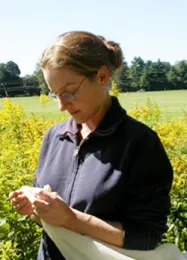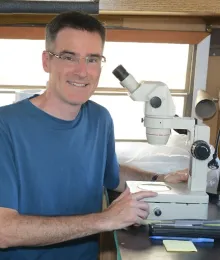Research Findings: Not Nearly Enough Bees Available for Crop Pollination

The researchers, led by Rachael Winfree of Rutgers University, New Brunswick, N.J. set out to answer the question “How many species do we need for crop pollination?”
They identified more than 100 species of wild bees pollinating watermelon, cranberry and blueberry crops on a total of 48 farms in New Jersey and Pennsylvania--the mid-Atlantic region of the United States.
The answer: “Not nearly enough bees are available for crop pollination,” Winfree said.
“We found that maintaining ecosystem services in nature requires many species, including relatively rare ones,” said Winfree, professor of ecology, evolution and natural resources. The publication, “Species Turnover Promotes the Importance of Bee Diversity for Crop Pollination at Regional Scales,” appears in the section, Ecology.
The ecologists first counted pollen grains of different bee species to measure bee pollination, tallied the number of bees and the different species pollinating the crops, and then figured out the minimum set of bee species that could meet various pollination needs. Finally, they plotted the cumulative number of bee species needed against the number of sites.

“So how many species do we need to ensure reliable crop pollination?” he asked. “The answer to this question helps us manage our agricultural and natural lands. Past studies suggest that often just a few bee species can do the job for any one site.”
The study, among the first of its kind, “reveals that when we look across multiple farm sites in a region, we need many more species than experimental studies have suggested in the past,” Williams said. “At one farm, pollination might rely on a handful of species, but across 40-50 farms in a region we need 10 times that number. This is because the most important species change from one place to another. “
So how many bee species are important to ensure crop pollination?
“More than we thought!” Williams said. “Working to promote bee diversity across regions is important for maintaining pollination and secure food systems.” The researchers counted 100 species of wild bees.
Winfree said previous experiments completed in the lab didn't answer the question: “How many bees do we really need?”
“When you have five (ish) bee species you get enough pollination,” she said “But there are only so many species you can even fit in an experiment. What we wanted to know is, how many bees do real farmers need to pollinate actual farms across an entire state?”
“Any one farm might need only a few species, but different bee species pollinate the different farms, so to pollinate all 50 (ish) farms we needed about 10 times as many species as are needed in smaller scale experiments,” Winfree said. “More than half of the 100 (ish) bee species we saw in the study were needed at some farm for some crop.”
Winfree, reiterating that “we need more bees than we thought,” said the issue is “important because many scientists are concerned that bees are in trouble. There is limited information on how most bee species are doing, but some of the species we do know about are declining. This work shows that preserving lots of bee species is important for food security.”
Other co-authors of the study are James Reilly of Rutgers; Ignasi Bartomeus of Rutgers but based at a biological station in Seville, Spain; Daniel Cariveau of Rutgers and the University of Minnesota; and Jason Gibbs of the University of Manitoba, Winnipeg, Canada.
A grant from the National Institute of Food and Agriculture (NIFA) of the U.S. Department of Agriculture funded the data collection research. Winfree conceived the study, oversaw the data collection, led the conceptual development and wrote the manuscript. Williams contributed to the conceptual development and manuscript preparation.
